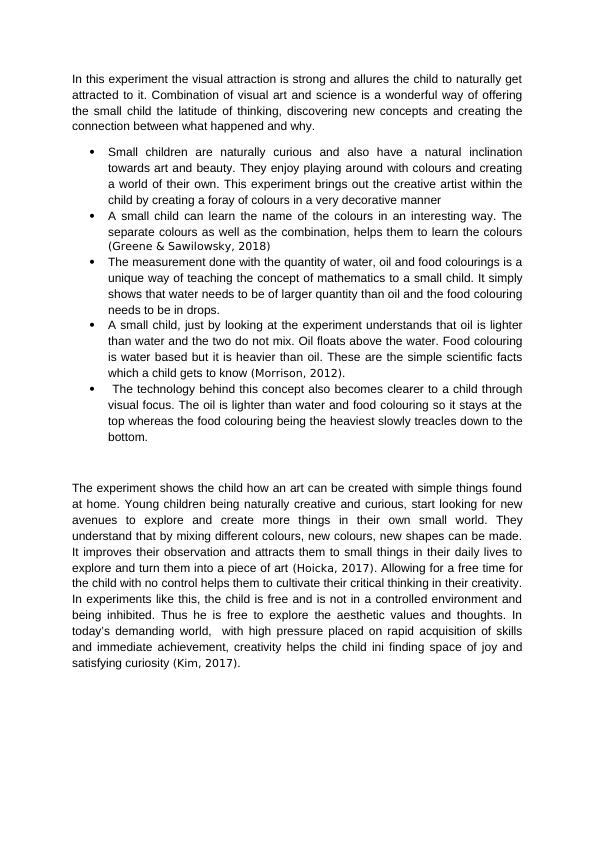Combining Art and Science: A Fun Experiment for Small Children
Added on 2022-11-12
2 Pages592 Words250 Views
In this experiment the visual attraction is strong and allures the child to naturally get
attracted to it. Combination of visual art and science is a wonderful way of offering
the small child the latitude of thinking, discovering new concepts and creating the
connection between what happened and why.
Small children are naturally curious and also have a natural inclination
towards art and beauty. They enjoy playing around with colours and creating
a world of their own. This experiment brings out the creative artist within the
child by creating a foray of colours in a very decorative manner
A small child can learn the name of the colours in an interesting way. The
separate colours as well as the combination, helps them to learn the colours
(Greene & Sawilowsky, 2018)
The measurement done with the quantity of water, oil and food colourings is a
unique way of teaching the concept of mathematics to a small child. It simply
shows that water needs to be of larger quantity than oil and the food colouring
needs to be in drops.
A small child, just by looking at the experiment understands that oil is lighter
than water and the two do not mix. Oil floats above the water. Food colouring
is water based but it is heavier than oil. These are the simple scientific facts
which a child gets to know (Morrison, 2012).
The technology behind this concept also becomes clearer to a child through
visual focus. The oil is lighter than water and food colouring so it stays at the
top whereas the food colouring being the heaviest slowly treacles down to the
bottom.
The experiment shows the child how an art can be created with simple things found
at home. Young children being naturally creative and curious, start looking for new
avenues to explore and create more things in their own small world. They
understand that by mixing different colours, new colours, new shapes can be made.
It improves their observation and attracts them to small things in their daily lives to
explore and turn them into a piece of art (Hoicka, 2017). Allowing for a free time for
the child with no control helps them to cultivate their critical thinking in their creativity.
In experiments like this, the child is free and is not in a controlled environment and
being inhibited. Thus he is free to explore the aesthetic values and thoughts. In
today’s demanding world, with high pressure placed on rapid acquisition of skills
and immediate achievement, creativity helps the child ini finding space of joy and
satisfying curiosity (Kim, 2017).
attracted to it. Combination of visual art and science is a wonderful way of offering
the small child the latitude of thinking, discovering new concepts and creating the
connection between what happened and why.
Small children are naturally curious and also have a natural inclination
towards art and beauty. They enjoy playing around with colours and creating
a world of their own. This experiment brings out the creative artist within the
child by creating a foray of colours in a very decorative manner
A small child can learn the name of the colours in an interesting way. The
separate colours as well as the combination, helps them to learn the colours
(Greene & Sawilowsky, 2018)
The measurement done with the quantity of water, oil and food colourings is a
unique way of teaching the concept of mathematics to a small child. It simply
shows that water needs to be of larger quantity than oil and the food colouring
needs to be in drops.
A small child, just by looking at the experiment understands that oil is lighter
than water and the two do not mix. Oil floats above the water. Food colouring
is water based but it is heavier than oil. These are the simple scientific facts
which a child gets to know (Morrison, 2012).
The technology behind this concept also becomes clearer to a child through
visual focus. The oil is lighter than water and food colouring so it stays at the
top whereas the food colouring being the heaviest slowly treacles down to the
bottom.
The experiment shows the child how an art can be created with simple things found
at home. Young children being naturally creative and curious, start looking for new
avenues to explore and create more things in their own small world. They
understand that by mixing different colours, new colours, new shapes can be made.
It improves their observation and attracts them to small things in their daily lives to
explore and turn them into a piece of art (Hoicka, 2017). Allowing for a free time for
the child with no control helps them to cultivate their critical thinking in their creativity.
In experiments like this, the child is free and is not in a controlled environment and
being inhibited. Thus he is free to explore the aesthetic values and thoughts. In
today’s demanding world, with high pressure placed on rapid acquisition of skills
and immediate achievement, creativity helps the child ini finding space of joy and
satisfying curiosity (Kim, 2017).

End of preview
Want to access all the pages? Upload your documents or become a member.
Related Documents
Teaching and Assessing Creative Arts for Primary Children: Backward Mapping and Learning Experienceslg...
|12
|886
|223
